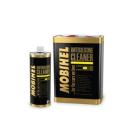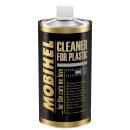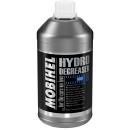Mobihel Body Degreaser

Mobihel professional bodywork degreasers
-
 407597xxAnti-silicone cleanerlow VOC
407597xxAnti-silicone cleanerlow VOC -
 40954742Degreaser for plastics750mL low VOC
40954742Degreaser for plastics750mL low VOC -
 41959412Hydro Degreaser1L
41959412Hydro Degreaser1L
︾
Discover Mobihel bodywork degreasers:
Hydro and Plastic Body Degreasers are products designed to remove greasy and oily contaminants from the surface of a car body, with an emphasis on formulations suitable for different types of surfaces, including plastic surfaces. Here's an overview of these two types of Degreaser:
1. Hydro Body Degreasers:
Water-based formulation:
Hydro body degreasers are formulated with water, which makes them less aggressive on the environment than some solvent-based degreasers. They are often chosen for applications where the reduction of volatile organic compound (VOC) emissions is a concern.
Grease and contaminant removal:
These degreasers are effective at removing grease, oil, wax and other contaminants from body surfaces. They create a clean base for paint, repair or surface treatment work.
Compatibility with different materials:
Hydro body degreasers are generally compatible with a variety of materials, including metals, plastics and rubber components. They offer versatility in cleaning applications.
Safer to use:
Due to their water base, these degreasers are often perceived as safer to use, with fewer safety risks for the user.
2. Bodywork degreasers for plastics :
Formulated for plastic surfaces:
Plastic Body Degreasers are specifically formulated to remove contaminants from plastic surfaces without damaging them. Some plastics can be sensitive to certain products, so these Degreasers are tailored to their specific needs.
Protecting plastic surfaces:
These degreasers are designed to clean plastic surfaces while protecting them. They can remove contaminants without causing degradation or tarnishing of plastics.
Preparation for Paint or Treatment:
Plastic body degreasers are commonly used before applying products such as primers, adhesives or protective coatings to plastic surfaces.
Versatility of use:
These Degreasers can also be used on other bodywork surfaces, depending on their formulation. Some can be multi-purpose, suitable for different surfaces, while others are specifically designed for plastic.
It is important to read and follow the manufacturer's instructions carefully for each product, as formulations and recommendations for use may vary. Correct use of these degreasers ensures proper surface preparation and contributes to optimal paint and surface treatment results.
Degreaser application steps:
Using a bodywork degreaser is a crucial step in preparing a surface before applying paint, Clearcoat or other treatments. Here are the general steps for using a bodywork degreaser:
Choosing the right bodywork degreaser:
Select an appropriate bodywork degreaser based on the specific needs of your project. Make sure the Degreaser is compatible with the type of paint or coating you plan to apply.
Protective equipment:
Before you begin, wear the appropriate protective equipment, such as nitrile gloves and safety glasses, to avoid skin and eye contact.
Cleaning the surface:
Start by cleaning the surface with a suitable bodywork cleaner to remove dirt, dust and other coarse contaminants. This will allow the Degreaser to work more effectively on tougher contaminants.
Shake the Degreaser:
Shake the Degreaser well before use to ensure that the active ingredients are evenly distributed throughout the product.
Applying the Degreaser:
Apply the degreaser to the surface using a cloth, sponge or spray gun, depending on the type of degreaser and the manufacturer's recommendations. Work in small sections to ensure even application.
Scrub or brush:
If necessary, use a soft brush or cloth to gently scrub the surface, particularly on areas where contaminants may be embedded. Be careful not to scratch the surface, especially if it is sensitive.
Action time :
Leave the Degreaser to work for the time recommended by the manufacturer. This time may vary depending on the product and conditions of use. Avoid letting the Degreaser dry on the surface.
Rinsing:
If recommended by the manufacturer's instructions, rinse the surface thoroughly with clean water to remove any degreaser residue. Some Degreasers require rinsing, while others can be left without rinsing.
Drying:
Allow the surface to dry completely before continuing with other steps, such as painting, varnishing or other treatments.
Checking cleanliness :
Once the surface is dry, visually check that it is clean and free of contaminants before proceeding with the next stage of your project.
It's crucial to carefully follow the manufacturer's instructions specific to the Degreaser you're using, as procedures can vary between formulations. Following the recommendations ensures effective use of the Degreaser and helps to achieve optimum results when carrying out bodywork.
All you need to know about applying bodywork degreasers:
Users frequently ask a variety of questions about applying Degreaser for Plastics and Hydro to a bodywork surface. Here are some common questions:
Degreaser for plastic :
Can I use a plastic degreaser on all the plastic surfaces of my bodywork?
Compatibility with different types of plastic may vary depending on the product. It is important to consult the manufacturer's instructions to confirm compatibility with your vehicle's specific surfaces.
Do I need to use a plastic degreaser before painting plastic parts?
Yes, the use of a plastic body degreaser before painting is recommended to remove contaminants and ensure optimum paint adhesion on plastic surfaces.
Can a plastic body degreaser damage the original colour of plastic parts?
Plastic degreasers are generally formulated to clean without damaging the original colour. However, it is advisable to carry out a test on a small, inconspicuous area to check compatibility.
Does a plastic degreaser need rinsing after application?
Some plastic degreasers require rinsing, while others can be left on without rinsing. It is important to follow the manufacturer's specific instructions.
Hydro Body Degreaser :
What's the main difference between a hydro body degreaser and a traditional degreaser?
The main difference lies in the base of the product. Hydro body degreasers are water-based, offering a low-VOC alternative to some traditional solvent-based degreasers.
Can a hydro bodywork degreaser be used before applying any type of paint?
In general, hydro body degreasers are compatible with various paints, but it is always advisable to check specific compatibility with the type of paint you plan to use.
Are hydro degreasers less effective than solvent-based degreasers?
Hydro body degreasers are effective at removing contaminants, but their effectiveness can vary depending on the product and application conditions. Some users may prefer solvent-based degreasers in specific situations.
Is a hydro bodywork degreaser suitable for all bodywork surfaces?
In general, hydro body degreasers are compatible with a variety of surfaces, but it is always advisable to check compatibility with specific materials such as plastic, glass, etc.
It is essential to refer to the manufacturer's instructions for each specific product, as formulations and recommendations can vary. Following the instructions carefully will ensure that the Degreaser is used effectively, minimising the risk of compatibility issues and ensuring quality results.